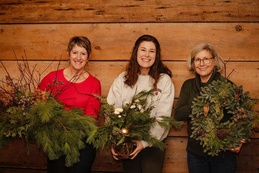The frog listeners
May 22, 2011
The frog and toad listeners that partake in the DNR’s annual Frog and ToadSurvey are a little like the “horse whisperers.” Both tend to the health
and well-being of a species.
The “listeners,” who cover over 500 routes statewide throughout every
Michigan county, listen to the calls of the frogs and toads at 10 sites
three times each spring and early summer. They identify the species
present and make an estimate of their abundance. Reports are sent to the
state which correlates the findings and the health of our state’s
amphibian population.
“This is our 16th year doing the annual survey,” said Lori Sargent, the
DNR’s longtime survey coordinator. “We’ve been collecting valuable data
to help evaluate Michigan’s frog and toad population. It’s way too early
to tell much about long-term trends, but this is a good start.”
ENVIRONMENTAL WARNING
Declining populations of frogs, toads and other amphibians have been
documented worldwide since the 1980s. Studies suggest amphibians are
disappearing due to habitat loss, pollution, disease and other issues.
“The frogs and toads are at the forefront of our environment,” explained
Sargent. “They are kind of like our ‘canary in the mine,’ which they used
to use to make sure air was breathable. If the canary didn’t survive it
was time to run. We are monitoring to make sure we don’t reach that
point.”
Michigan is among the leading Great Lakes states doing such surveys. Only
Wisconsin has been doing it longer by a few years.
The program is dependent upon volunteer support, and one of those who has
been doing it since its inception is Bob Carstens a retired educator who
lives in the Grand Traverse region. He’s been covering the same 10
wetland sites for the past 15 years.
“When I first heard about the survey I volunteered right away to do it for
Grand Traverse County,” said Carstens, who is also an avid birder. “I
already had routes around the county for birding surveys that seemed a
natural fit.”
Over the previous 15 years there hasn’t been a lot of change in the frog
and toad populations locally that he’s observed, which goes along with the
overall state trend so far, according to Sargent.
“The biggest problem that’s been observed so far is fluctuating water
levels,” she said, “but they seem to come back strong when levels are near
normal.”
“My counts are good this spring and may be up slightly over last year,
which was a drier spring,” Carstens explained.
“This spring the wood frogs were as abundant as I can recall, and now the
spring peepers and American toads are in full chorus tonight,” he pointed
out as we walked along one of the ponds that he covers on a recent spring
night. “There are a few chorus frogs as well and eastern gray tree
frogs.”
There were high flute-like trills from the tree frogs and American toads,
a few steady low percussion-like “brrrrrrt-brrrts” from green frogs, and
the swirling, wall-to-wall sound of the spring peepers; a little frog with
a big voice. Phil Specter would have been proud.
VIBRANT SOUNDS
To my untrained ear it was a pleasant mish-mash of wetland sounds, which
was very vibrant. To Carsten’s trained ear he could pick out the various
species and estimate numbers based on previous years and counts, which was
the purpose of visiting each site three times about the same time each
year, for consistency.
They are always looking for more volunteers. Participants are trained by
listening to tapes of the various frog and toad calls. After doing it for
a couple of seasons, according to Carstens, you become pretty proficient
at identifying the various calls even though some are similar. For those
interested in participating or learning more you can contact Sargent at
SargentL@michigan.gov.
The most abundant species in our region are the spring peepers, green
frogs, gray tree frogs, American toads, west chorus frogs and wood frogs.
You might also see or hear an occasional northern leopard frog and
bullfrog. It’s hard to miss that big bass “gunnnnk” of the bullfrog.
Now is the time to take a walk on a warm night just after dark along a
wetland or pond. Stop and just listen. It’s an incredible sound of
almost musical-like notes, and when you listen intently the different
sounds are detectable.
It’s nature’s chorus and very soothing to listen to. Just don’t forget
the bug spray.
Trending

Fighting Harder for Local Women and Children
Traverse Bay Children’s Advocacy Center (TBCAC) has been navigating a particularly challenging year. Though CEO Lande… Read More >>
Christmas in Sweden (by way of Benzie)
Musical duo Ingemar and Lisa Johansson, also members of Song of the Lakes group, bring “Christmas in Sweden: A Musical… Read More >>
Searching for a Sugar High
In the words of Cookie Monster, “NOM NOM NOM.” It’s cookie season, and we’re here for every gingerbr… Read More >>


